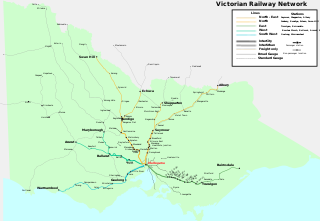
Rail transport in the Australian state of Victoria is provided by a number of railway operators who operate over the government-owned railway lines. The network consists of 2,357 km of Victorian broad gauge lines, and 1,912 km of standard gauge freight and interstate lines; the latter increasing with gauge conversion of the former. Historically, a few experimental 762 mm gauge lines were built, along with various private logging, mining and industrial railways. The rail network radiates from the state capital, Melbourne, with main interstate links to Sydney and to Adelaide, as well as major lines running to regional centres, upgraded as part of the Regional Fast Rail project.

Thirlmere is a small semi-rural town in the Macarthur Region of New South Wales, Australia, in Wollondilly Shire. Popularly known for its railway origins, the town is located 89 km south west of the Sydney Central Business District. At the 2016 census, Thirlmere had a population of 4,046.
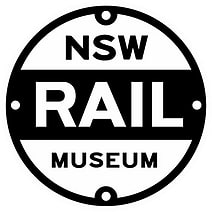
The NSW Rail Museum is the main railway museum in New South Wales, Australia. A division of Transport Heritage NSW, it was previously known as the New South Wales Rail Transport Museum (NSWRTM), Rail Heritage Centre and Trainworks.
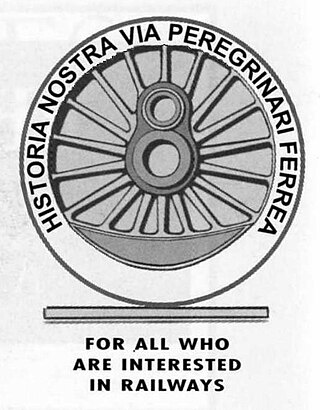
The Australian Railway Historical Society (ARHS) aims to foster an interest in the railways, and record and preserve many facets of railway operations. It has had divisions in every state and the Australian Capital Territory, although the ACT division was wound up in 2016, along with the Victorian division in 2020. Since 1967, when each division incorporated, the state divisions have operated as separate entities. Each still trades under the ARHS brand, except in Western Australia, where the division is called Rail Heritage WA. Individual membership exceeds 2,500.

Glenreagh Mountain Railway, known as the GMR, was established in 1989 as a heritage tourist railway at Glenreagh, near Coffs Harbour, New South Wales, Australia. GMR's objective is to restore and operate a heritage tourist railway on the Glenreagh to Ulong section of the Glenreagh to Dorrigo railway line.

3801 is a 4-6-2 steam locomotive operated by the New South Wales Government Railways between 1943 and 1974. It is arguably Australia's most famous steam locomotive, being the only one to have visited all mainland states and territories.

The Lachlan Valley Railway Society is an Australian rail preservation society based in the New South Wales Central Western town of Cowra. It was established in 1974 to preserve and operate former New South Wales Government Railways locomotives and rolling stock. It operates regular heritage train tours to a variety of locations across New South Wales.

The 620/720 class railcars were a class of diesel multiple unit built by the New South Wales Government Railways and operated from 1961 until 2007.
Railmotor is a term used in the United Kingdom and elsewhere for a railway lightweight railcar, usually consisting of a railway carriage with a steam traction unit, or a diesel or petrol engine, integrated into it.
The Picton–Mittagong Loop Line is a partly disused railway line between the towns of Picton and Mittagong in the Southern Highlands of New South Wales, Australia.
The railways of New South Wales, Australia, use a large variety of passenger and freight rolling stock. The first railway in Sydney was opened in 1855 between Sydney and Granville, now a suburb of Sydney but then a major agricultural centre. The railway formed the basis of the New South Wales Government Railways. Passenger and freight services were operated from the beginning. By 1880, there was a half hourly service to Homebush.

The Bombala railway line is a branch railway line in the south of New South Wales, Australia. The northern part of it forms part of the main line from Sydney to Canberra, but the southern part is closed. It branches off the Main South line at Joppa Junction, south of Goulburn. The line is used by NSW TrainLink Xplorer services running between Sydney Central and Canberra station.

The Gulflander is a passenger train operated by Queensland Rail on the isolated Normanton to Croydon line in the Gulf Country of northern Queensland, Australia.
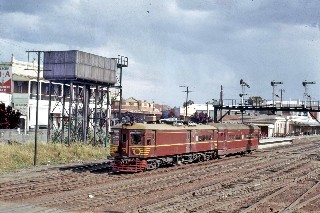
Creamy Kate is a former New South Wales Government Railways railmotor, numbered 38. It is an evolution of the CPH rail motor class.
The Oberon Tarana Heritage Railway inc (OTHR) is a volunteer association aiming to reopen the Oberon to Tarana railway line in the Central Tablelands of New South Wales, Australia, and run heritage trains.

The Rail Motor Society, based at Paterson, New South Wales, is a community owned collection of preserved self-propelled railway vehicles and equipment from the former New South Wales Government Railways and its successors. The items in its collection date from 1923 through to 1972.

In 2013, Transport Heritage NSW was established by the Government of New South Wales to manage the State’s rail heritage collection and provide support to the broader transport heritage sector in NSW following an independent review.
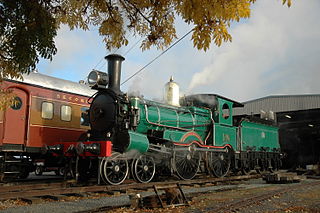
1210 is a preserved former New South Wales Government Railways Z12 class steam locomotive. Built in 1878 by Beyer, Peacock & Company, England, it is preserved at the Canberra Railway Museum.
The D1 class were a class of diesel locomotives built by Commonwealth Engineering, Granville with English Electric traction equipment for Australian Iron & Steel's, Port Kembla steelworks in 1950–1951.

The Cooma Monaro Railway is a not-for-profit heritage railway museum that is actively restoring the Cooma Railway Precinct while working on the restoration of tourist trains along the section of track on the Bombala line between Cooma and the terminus at Bombala in New South Wales, Australia. The CMR operates a museum inside Cooma Railway Station called the "Travel for Pleasure" exhibit, showcasing the history and significance of the Bombala Line's previous operations. The museum also showcases a vast array of rolling stock and other former rail assets. CMR are also undertaking multiple restoration efforts, in order to increase revenue and allow the reinstatement of tourist CPH services from Cooma Station to Snowy Junction. The restoration efforts include;



















